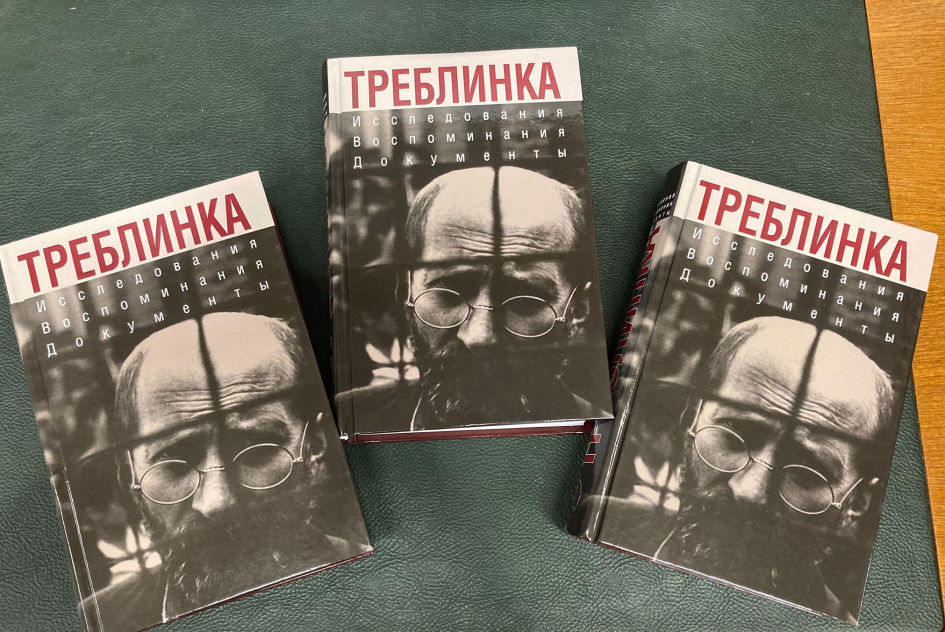The editors’ team of the “Nuremberg: Casus Pacis” project has published excerpts from the book “Treblinka: Research. Memories. Documents” prepared by the Russian Military Historical Society (RVIO). This book makes a staggering impression even on a prepared reader.
Our editing team has interviewed the author of the idea and executive editor of the publication, historian, associate professor of history at the Moscow State Pedagogical University, and deputy director of the Department of Science and Education of the Russian Military Historical Society, Konstantin Pakhalyuk, who had previously compiled collections about Sobibor and Majdanek. Today, we present you the first part of this big conversation about what it was like to work on this book and how one can cope with at times unbearable discoveries.
Reference: “The Hell of Treblinka” is the title of an essay by Vassily Grossman. In November 1944, it has seen light in the literary magazine “Znamya”, and then distributed as a pamphlet at the Nuremberg Trials. Former prisoners of the Treblinka extermination camp were witnesses at Nuremberg. Echoes of these terrible times are still being heard to this day – new information and facts are uncovered and previously inaccessible documents are unearthed in the archives. The book “Treblinka: Investigations. Memories. Documents” unites and introduces a whole range of sources and materials. It contains research materials on the history of the camp, the collaborators who committed the most horrible atrocities, the Wachmänner-Trawniki (“watchmen”), the evidence that crushes the arguments of Holocaust deniers. There are memoirs published in Russian for the first time that have become key sources in Holocaust historiography. Moreover, there is a whole complex of never-before-published documents prepared by the Soviet investigative authorities - testimonies and protocols of interrogations.
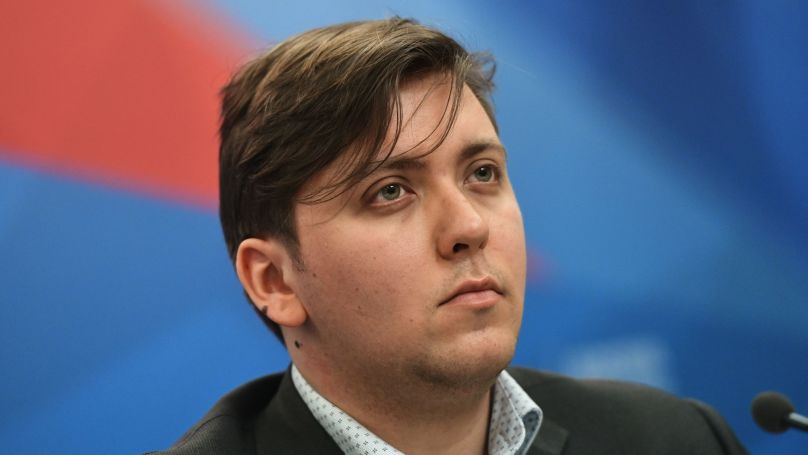
– A quote from the book: “There is still a certain paradox: many narratives of Nazi atrocities may be well known to the Russian public, but there is no proper scientific research in Russian. Until now, this was also true of Treblinka: this death camp, described by V.S. Grossman as early as 1944, unfortunately, did not attract the interest of domestic researchers, and the numerous documents stored in Russian archives were little known. This is probably partly because this history was not recognised as related to our country's past. Unlike, for example, Auschwitz or Sobibor. That is not really the case”. Could you be more specific: what do you see as a set of reasons why Treblinka remained outside of major domestic studies for so long? After all, “Life and Fate”, if not when written by Vasily Grossman, then at least in the post-perestroika period, had already set a precedent of “connection with our country's past" - and yet, for almost 40 years, it “did not attract the interest of domestic researchers”.
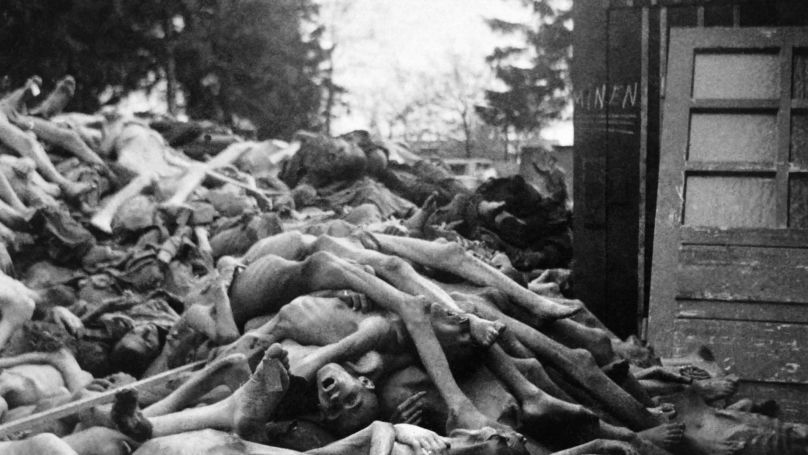
– The Holocaust is still not fundamentally perceived as "our history". Yes, part of the history of Nazi crimes, yes, the Jewish tragedy, but still as something not ours, alien and therefore optional and unnecessary. Which is sad. After all, largely the Jews murdered were residents of the Soviet Union, up to 40 per cent of the 6 million victims. After all, the Holocaust as a Nazi policy of consistent physical extermination begins on Soviet territory. Because the various Nazi strategies of extermination, suppression and extermination are so closely intertwined that to say "this is someone else's, not our grief" is morally despicable and blind. Just as today one cannot look at the problem of ecology from a narrow "national" perspective - that is, limited by state borders - so the tragedy of those who were victims of Nazi crimes cannot fit into a clearly defined, comfortable national, state framework. The Holocaust is as much a part of our history as it is of the history of Europe and the world.
Unfortunately, Treblinka did fall out of the public eye. Perhaps partly because Vassily Grossman's essay “The Hell of Treblinka”, published in 1944, made the subject fairly well known and so no further research was attempted.

Of course, the restricted access to documents during the Soviet era played its part. Today, I think it is important to resume work on overcoming this wall - the wall of not wanting to know, and therefore not being able to sympathise with the "other" victims, the "different" victims. And this is why the issue of Treblinka is so significant.
– A quote from the book: ЭThe documents published below were found in the collections of the State Archive of the Russian Federation - collection P-7021 (Extraordinary State Commission) and collection 7445 (Nuremberg Trials Materials). The fact that some of the original testimonies of prisoners from both camps were kept in the latter collection indicates that they were intended to be used at the Nuremberg Trials. They were even marked with the Nuremberg document number "USSR-436" on the cover of the case but they were never used at the process”. Do you have any theories as to why this did not happen?
– We have no direct information as to why these documents were not used. In general, we can assume that since the witnesses at the Nuremberg Trials had already raised the subject of Treblinka, such as Reisman* (we publish minutes of his examination by Soviet interrogators in 1944), the Soviet prosecutors decided to focus on other topics. The “Jewish Question” was not a principal task for the Soviet side, and most of the Jews murdered at Treblinka were not Soviet citizens. Unfortunately, it so happens that when you talk about the universality of tragedy while paying no attention to details when you express private tragedies in a claim to universal ideological language, you are less believed, and you yourself miss very significant subjects.
(*Samuel Reisman, a Polish Jew who was imprisoned at Treblinka from September 1942 to August 1943, gave testimony to Second Lieutenant Jurowski on 26 September 1944 – ed. note)
From the interrogation report of Samuel Reisman on the operation of the Treblinka extermination camp, Węgrów, 26 September 1944:
“I will give just a few examples of the facts I witnessed. A train arrived from Vienna. Among others was the sister of the famous Austrian psychology professor Sigmund Freund, a woman in her fifties. Right there on the platform she approached SS Untersturmführer Kurt Franz, the deputy camp commandant, and asked him to put her in some light clerical work, as she had no strength, and was an accountant by profession. In a strikingly polite tone, Franz asked her for her identity documents. After looking through all the documents, he courteously replied, ‘Yes, you are indeed Sigmund Freund's sister. Look, there has been a mistake. You are not subject to eviction from Vienna. That is all right, we will fix that. You should leave all your belongings and jewellery for safekeeping, take a bath, and then I will send you home on the first train”. Thereby he led her to the timetable posted on the platform and in a very serious tone expressed his opinion that she should take one train and not the other. The unfortunate woman had no doubt whatsoever about this courteous advice. She followed that advice, gave up her belongings to Franz, and went to the ‘bath house’ from which she never returned. In May 1943, an acquaintance of mine, Stein, an assistant professor at the medical faculty of the University of Warsaw, was brought into the camp. He introduced himself to SS Hauptsturmführer Franz Stangl, the camp commandant, and asked him for a job in his profession. Stangl asked him to wait a few minutes. Kurt Franz soon comes out with his dog Barry and sets it loose on Stein, while he stands back, smiling and watching as the dog begins to tear the flesh off Stein's body. Stein, half-dead and covered in blood, was carried on a stretcher to the ‘sick bay’, where he was thrown into the fire. One day in the autumn of 1942, an elegantly dressed man got off the train. Hauptsturmführer Stangl, who was on the platform at the time, greeted him enthusiastically and took him to his chancellery if he were a friend. We were all very surprised because the man who had come was a Jew. Stangl played around with him. After a while, they both walked out of the camp. We heard a shot. Stangl went into the camp alone, without his companion, ordered us to pick up the corpse and take it ‘to the fire’. In front of the infirmary, we started to remove his belongings and from the papers, we saw that he was a brother of the Soviet ambassador in Paris, Jacob Suritz".
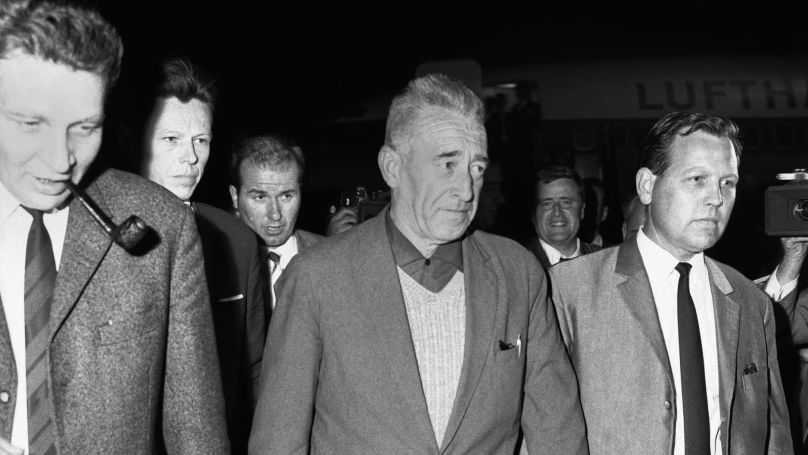
– What kind of attitude in the professional community have you personally encountered after publishing the collected and analysed materials? If critical, what exactly is being criticised? If condescending or indifferent, why is that, in your opinion? Is there a feeling that someone has picked up on the subject?
– When I made the first announcements about the publication of the collection, I received quite a wide response from quite different people, both from a professional point of view and in terms of ideological and political views. The book attracted interest in Poland, the UK and Israel. That is, the relevance of Treblinka goes beyond national, cultural and political boundaries. It seems to be a "purely Jewish" story, but it turns out to be common to all humankind. One can predict that those who deny the Holocaust will greet this book with hostility. As was the case, for example, with the book about Majdanek – after its publication, we received letters from offended deniers, saying that their texts were not included in the historiographical section.
– And why is that?
– Because historiography is all about a scientific study, focused on the search for truth, while the literature of the deniers is cheap opinion-based journalism. However, we considered this criticism this time and, at my request, Sergey Romanov wrote an article detailing the myths of the deniers about Treblinka. However, in Russia, of course, the problem of Holocaust denial is somewhat different: yes, it also involves xenophobia and anti-Semitism but it is not a reaction to an active policy of commemorating the victims. Note that until recent years, it was easier to find works in Russian by those who downplayed the scale of the tragedy than by those who studied it. When it comes to the Holocaust in Russia today, the key complaint is still different: why are we not supposedly talking about the extermination of the Russian people in the first place, about the so-called "genocide of the Soviet people". Yet the "old-fashioned" inability to sympathise with the other is still behind it.
– And what can systemic deniers oppose your findings?
– Absolutely nothing. Moreover, the documents we publish once again prove that Treblinka was – certainly! – a place of extermination, and everything we know about it is reliable in principle. We have published over 30 interrogation protocols from August and early October 1944, prepared by the Soviet Military Prosecution Authorities as part of the overall investigation of the crimes at the Treblinka camps. These documents have long been kept in the State Archive of the Russian Federation (GARF), some of which have been used in contemporary research as sources for quotations, and this is the first time we are publishing them in full. The history of Treblinka was originally written abroad on entirely different sources, and the fact that our documents generally corroborate those sources is an important indicator of the reliability of our knowledge of this death camp.
Naturally, the perception of the public discourse on Treblinka also has other dimensions. There are those of an older generation who believe that describing Nazi crimes in such detail in public space is not permissible. This is a kind of moral argument based on a particular understanding of public space – far from enlightened standards (places where rational individuals exchange reasoned opinions). Some believe that the emphasis should be on the so-called "genocide of the Soviet people" and, accordingly, the subject of Treblinka is a "side issue" for them. And this is already a question of emphasis, it has nothing to do with the meaning of Treblinka (its understanding), but with the significance to be given to it. Some believe there is a need for such a book but for some reason consider it an accusation against the Poles, when our aim categorically was not to stir up any ethnic hatred. Yes, there are pages highlighting the villainy of many Poles who betrayed Jews (this is a very painful topic for Samuel Willenberg, who was shot in the back by his own soldiers of the Armia Krajowa during the Warsaw Uprising because he was Jewish), but there are also enough stories about how Poles helped, hid and saved Jews. Ultimately, the “media anti-Polish sentiment” that manifests itself in the texts of certain authors is temporary, opportunistic and transient, so there is no point in paying attention to it.
– How did the work progress from idea to print? Which stages would you like to highlight in particular?
– The idea came up purely by chance when I was finishing a compilation about Majdanek and was checking the sets of documents against the originals in the archives. Then I came across several interrogation reports of prisoners of the Treblinka camps, as well as a translation of the memoirs of Jankel Wiernik, who escaped from the death camp. They had never been published in Russian, although they are well known internationally as one of the key sources for the history of the Holocaust. I wanted to prepare these documents for print, to make a small booklet. Leonid Terushkin, a colleague from the Russian Research and Educational Holocaust Centre, suggested including the memoirs of Samuel Willenberg since he was the last survivor of Treblinka, and his wife is still alive today, speaks Russian, and was aware of the preparation of this book.
We started our work - and encountered several difficulties. First, there was the difficulty of cross-checking the archival translation of Wiernik's memoirs with the Polish original. I asked Igor Zhukovsky, the then head of the Russian House in Warsaw, and the translator Lidia Kovaleva to do this. Then, already engaged in editing and commenting on the translation, I started an independent verification of the first English edition, putting under the texts of memoirs in Russian, English and Polish, going line by line and consulting each discrepancy with the translator. And it turned out that there were many discrepancies even in the English version, including the number of victims. Such inaccuracies in our compilation we noted in the comments. Similarly, Igor Zhukovsky helped us a lot with the collation of Willenberg's memoirs. It was based on the first publication in Hebrew, and Grigory Reichman, our compatriot living in Israel, undertook the translation. I asked Igor to help verify the translation in Polish, as it was Willenberg's mother tongue. There were many serious discrepancies, even to the extent that the Polish version is more detailed and it better reflects the vicissitudes of Polish-Jewish relations during the Nazi occupation.
– How would you explain these discrepancies?
– I would attribute the discrepancies in Wiernik's story to the speed of preparation of the translation at the time, the translators' unwillingness to delve into all the subtleties of literary language, some carelessness and lack of understanding of metaphor, and ignorance of the cultural context. For example, at the very end, when a watchman catches up with the fleeing Wiernik, the latter retaliates by hitting the guard in the chest with an axe. In the English version, the guard cries out "Uh!", while in the Polish version he shouts "Motherfucker!" Of course, an English-speaking translator cannot sense such subtleties, whereas for a Russian-speaking translator they are obvious.
As for Willenberg’s case, I think the discrepancies are related to the fact that publishers in Israel simply removed the "uninteresting", as they thought, context. Moreover, not just Polish. Willenberg remembers how in January 1945 the Polish partisans were waiting for the Red Army, and the Israeli version removed the whole scene of them going with the Red Army to capture one of the bridges held by the Germans. It is difficult for me, however, to explain the differences found by political and censorship considerations. After all, Willenberg was one of the organisers for Israeli youth’s trips to Poland, to the sites of the tragedy, and it would be pragmatic to correct and smooth out the Polish version.
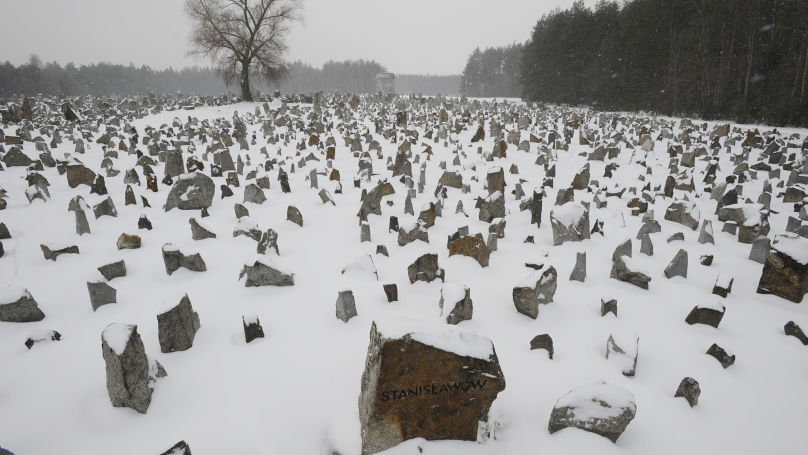
By the way, the attitude to the Jewish tragedy in Poland at that time was not straightforward. Let us not forget the anti-Semitism that flourished not only during the occupation but also in the post-war period, from the 1946 pogroms to the Six-Day War, when in the name of the fight against Zionism the last Jews were effectively expelled. In today's Poland, attitudes are also quite contradictory. However, since the 1990s, the Holocaust has been at the centre of Europe-wide remembrance policy, tens of thousands of Jews come to Poland every year (this attracts tourists and funds), which is why it is impossible for Poland not to deal with the subject of the Jewish tragedy. Memorials, museums, monuments, souvenirs, ceremonies - all of these are needed. And we cannot say that there are no people and cultural elites in Poland who would not be prepared to speak openly about the Holocaust and the complicity of Polish nationalists in it. On the other hand, for the conservative part of Polish society, this conversation is a very painful topic. They want to see the Poles as the ideal victim of the two regimes - Hitler and Stalin - rather than dilute this image at the expense of moral reflection. Naturally, this does not deny the heinousness of Nazi occupation policy in Poland, the mass shootings and repressions of which we in Russia do not know much about either.
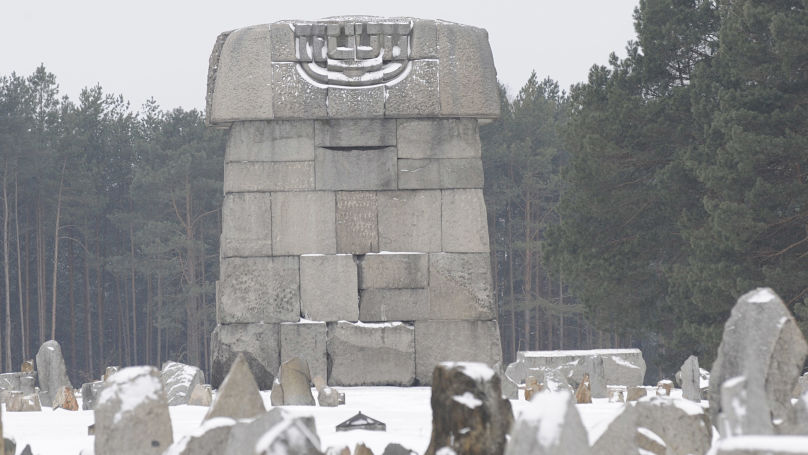
Jankiel Wiernik was a Polish Jewish Holocaust survivor. At Treblinka, he worked for the Sonderkommando, among others. He took an active part in the Treblinka Uprising, during which he escaped and joined the Resistance movement. In 1944, he published his memoirs “A Year in Treblinka”, which became one of the key Holocaust memoirs. He witnessed at the trials of Ludwig Fischer, Adolf Eichmann and the Treblinka trials.
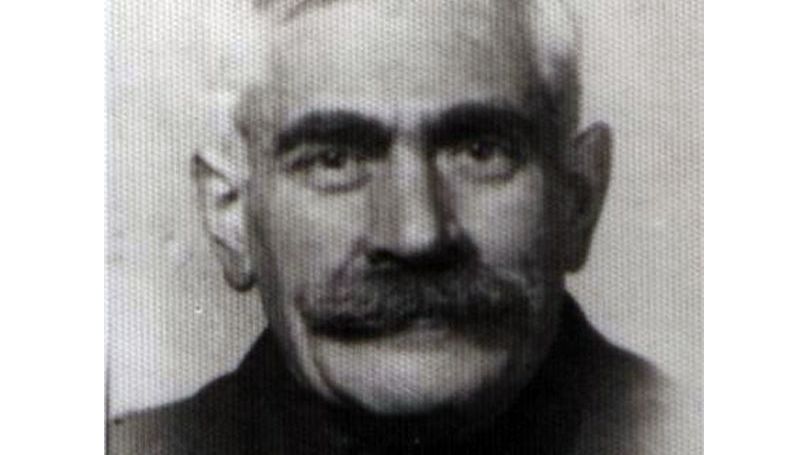
From Jankiel Wiernik's memoirs “A Year In Treblinka”:
“One day an Oberscharführer with an SS badge arrived at the camp and gave instructions to create a real hell for us. He was a man of about 45 years of age, medium height, always smiling, his favourite word was 'tadellos'* (in German 'flawless' – ed. note), hence his nickname – Flawless. His face, very kind, did not express what was in his mean soul. He took real pleasure in looking at the burning torches of corpses. That flame was a great phenomenon to him. He caressed it with his gaze, lay beside it, smiled and spoke to it. He kindled this hell in this way: he adapted a machine that dug up corpses, the so-called bagger, which took out 3,000 corpses at a time. A grid of iron rails was laid on concrete posts 100-150 meters long. The workers piled corpses on the bars and set them on fire. I am not a young man and I have seen a lot in my life but Lucifer himself could not have created a worse hell. Can anyone imagine such a long grating on which lie the 3,000 corpses of people who were alive not long ago? You see their faces, it seems that in a minute these bodies will snap and wake up from a deep sleep. And here a torch is being lit by order, burning with a living flame. If you stand not far away, it seems to be the sleeping ones moaning, that the children are about to jump up and cry ‘mommy’. Fear and pity embrace you, and yet you stand, working silently. The bandits, standing by the ashes, laugh with satanic laughter, devilish pleasure sparkling in their eyes. On this occasion, they drink vodka, the finest liqueurs, and snack on delicacies. Even after death, the Jew makes himself useful. It is a bitter winter but there is a blast of heat coming from the ovens. This heat comes from burning Jewish bodies. Bandits warm themselves by them, drinking, eating and singing. The bonfire is gradually dying out, leaving only ashes to fertilize this silent land. The earth is drenched with human blood and sown with the ashes of human bodies. Then it will be fertile. If it could speak, it would tell a lot. It knows everything and remains silent. The days went by, and the poor workers grieved, died, became swollen out of hunger beside the corpses. And day after day the bandits' hearts filled with pride and pleasure. They were perfecting hell. It was clear and warm - torches were burning, traces of the executed were disappearing, our hearts were bleeding. And the Oberscharführer sat by the bonfire, laughing, caressing it with his gaze, saying 'flawless' to it, seeing in this bonfire the fulfilment of his perverse dreams and dares. The burning of the corpses succeeded. Since the Germans wanted to buy time, the construction of new bars began. The teams increased and burned ten to twelve thousand people at a time. All hell set loose. Looking at the bonfire from afar, it looked like a volcano spewing fire and lava. Everything around it was whistling and crackling. Up close, there was so much smoke, fire and heat that one could not stand it”.
– The next stage was to prepare for the publication of the interrogation reports. Then Sergey Romanov provided us with a number of other protocols that were kept not in the Extraordinary State Commission collection, but specifically in the Nuremberg Collection, and this accordingly doubled the number of documents. We also prepared for publication a number of testimonies about how the Soviet investigation went in August-October 1944.
At the same time, we were working on the research block. Mikhail Edelstein and I made an introduction, summarising the history of Treblinka with the help of contemporary documents. At the same time, I invited Aaron Schneier to write an article about the "Trawniki" guards, and Sergey Romanov – about the deniers. This made for a large, voluminous book, although I had originally thought of a small booklet.
The Treblinka collection is fundamentally a collective work. Quite a number of people agreed voluntarily and virtually "for the idea" to take part in it. Science is a collective endeavour, and this improves the outcome. Reichman helped not only with the translation of Willenberg but also with the clarification of many details. Romanov helped not only with the article but also with providing perhaps the most interesting documents. Likewise, Mikhail Edelstein, who knows very well many realities of Jewish and Polish life of that time. Leonid Terushkin provided assistance with Willenberg and the editing of the set. Without the help of Igor Zhukovsky, we would hardly have been able to make semantic reconciliations of the different translations. Nikolay Khripushin is an archivist, and when it turned out that we could not reconcile a number of sets because we had a very poor quality photocopy and needed the original, which was impossible to get at because of quarantine measures, he, being an archive employee, kindly agreed to help with the reconciliation. This, too, is an indicator that the subject of Treblinka is one of genuine importance.

From a discussion on Konstantin Pakhalyuk's Facebook page:
Sergey Romanov: There is an interesting phenomenon of "erasure of meaning" in relation to the extermination camps, when everyone, on a basic cultural level, seemed to have heard of the horrible Treblinka (for example, Korczak and so on), but in fact, did not know anything about it and could not distinguish it from Buchenwald or Dachau (besides, Treblinka was incorrectly referred to as a “concentration camp”). This, I should point out at the outset, is not a rebuke to the Soviet side in particular, since the same thing happened in the West. It contributed to the formation of a certain monolithic image of the system of concentration and extermination camps in the minds of ordinary people. Resnais’ “Night and Fog” comes to mind. At the same time, most of the extermination camps were not concentration camps. It is clear that the fact that the best-known and largest concentration camp and the largest extermination camp were the same – Auschwitz-Birkenau – also played a role.
Grigory Reichman: We were just talking about Korczak with "Mrs Willenberg", as I call Adochka, Ada Willenberg, and I expressed my opinion about the legend that supposedly a German officer at Umschlagplatz (German for ‘transfer point’ – ed. note) offered Korczak to stay and keep himself alive, she had heard it more than once from some Holocaust survivors - natives of Poland. Legends, myths never die... I believe he himself was separated from the children and killed in the "Infirmary" where the elderly were sent, killed on the edge of a ditch with smouldering corpses, shot in the back of the head.
– What is unique about Treblinka in particular? How would you formulate the difference from other death camps?
– It was one of the most effective extermination camps in 1942 and bore the brunt of the “Final Solution to the Jewish Question” at the time. More than 700,000 Jews were killed there intermittently during the year from the end of July 1942 to the end of August 1943. It is a well-organised conveyor belt – much better than the Belzec, which the Nazis had to close after killing 440, 000 Jews there and run out of place to bury them. Treblinka is much bigger than Sobibor, although it was built “on its motives”. It differs from Auschwitz, which was both a death camp and a concentration camp and bore the brunt of the extermination in 1943-44, peaking in 1944 with the destruction of the Budapest Ghetto. In this respect, Rudolf Höss (Commandant of Auschwitz) certainly took the initiative from Odilo Globocnik (responsible for “Operation Reinhard”, during which Treblinka was created).
From the minutes of Shimon Tszegel's interrogation of the Treblinka forced labour camp and the situation of the Jewish prisoners, Kosow Lacki village, 22 September 1944:
“In July 1942, 350 Jews were brought to the camp from Warsaw. Among them were about 100 boys aged 12 or 13. These boys and 30 adult men were left in the camp. The remaining 200 were shot. SS Unterscharführer Einbuch led this execution. The SS men carried out the execution. In the last days of July, I remember well how SS Untersturmführer Prefi made 100 boys sing songs all day long on Saturday. And in the evening he selected 50 of them who were the strongest and shot the rest of them in the woods on the same day. Of the 50 who remained in the camp, the next day they were sent to work at Malkinia station. Two of this group escaped. When they returned to the camp, SS-Untersturmführer Stumpe and Gruppenwachmann Munke arranged for 18 boys to be shot as punishment. I was not in the woods where they were executed. I saw them all being rounded up and led into the forest. On the way, the Wachmänner guards whipped them with sticks and the butts of their carbines. After a few minutes, a volley sounded. The Wachmänner guards came back without the boys. It should be noted, however, that the Germans and the Wachmänner never took anyone far away for a firing squad. On the contrary, they did everything in their power to make their atrocities or menaces known to all of us.
Doctors Mihovsky and then Olzer periodically examined the prisoners. Those whom they found ill the Germans took to the woods and shot on the same day.
“Bullet was the only remedy in the camp”.
It was mid-January 1943. The camp commandant, SS-Hauptsturmführer Theodor (Theo) van Eupen, announced that he was going to the Warsaw Ghetto for specialists. On the same day, 37 Jews who were sick, with frozen hands and temporarily incapacitated, were assigned to the camp. They were ordered to clean the latrines and carry all the filth on stretchers into the woods. The first two went into the woods. They did not return. The second two went into the woods and did not return either. The others realised what the matter was and refused to go into the forest. Then some Wachmänner, one of them called Mikola, came out of the forest and beat the others to death with sticks. One must admit that Mikola had an uncanny knack for taking a man's life with a single blow to the head. He unmistakably struck one and only one blow. That was enough. He had become so adept at taking people's lives quickly and easily without the cost of lead. All these human freaks were as if competing with each other in cruelty. In January, a carload of turnips was brought to the camp. One of the camp labourers took one turnip and began to eat it. Prefi approached him and offered to open his mouth and show him what he was eating. The Jewish worker obeyed. As soon as he opened his mouth, Prefi fired his gun straight into his mouth. The victim dropped dead. One evening in February, I was on my way back to my barracks from the commandant's office, where I was repairing a wardrobe. Late at night, one by one, the workers were coming back to the camp from Malkinia station. Unterscharführer Schwarz, Rottenführer Weisser, Gruppenwachmann Braun and Shannikov were standing at the gates on one and the other side. As soon as a labourer came into the camp, one from this group would push him to the opposite side, and the one opposite would hit him on the head with a wooden hammer. The one who wielded the hammer the most was Braun. His one blow with the hammer took a man's life. It was a short and precise blow. Braun had achieved such virtuosity in the field of manslaughter. In April, sitting in my workshop, I heard a terrible scream. When I looked out of the window I saw three Wachmänner guards (I do not know their surnames) chopping the heads of Jewish workers with axes. They had killed seven people. I found out a little later the reason for this savage massacre. A group of Jews were sent into the forest to work. A few escaped. Then all the others were brought to the camp. Seven were killed with axes. The others were beaten with sticks. All such massacres were always carried out by the Wachmänner guards with the knowledge and at the orders of Unterscharführer Einbuch. One could always see Unterscharführer Schwarz with a stick in his hand. He always liked to ask the question, “Do you want to live?” (Willst du leben?). When the answer was 'yes', he would hit with the stick as a reward. I remember in April a group of us, Jewish workers, were out clearing snow. One of our group, apparently due to fatigue, went to the latrine. Schwarz dragged him out of the restroom and asked him his patented question: "Willst du leben?" ("Do you want to live?"). He replied, ‘I do’. Schwarz swung his stick and struck him as hard as he could on his torso. He fell. Schwarz asked the man, moaning in terrible pain, the same question again. The man barely spoke through gritted teeth ‘I do’. Schwarz struck him with the stick again. This time on the head. The man died”.
– A quote from the book: “The lack of crematoriums should not be disconcerting - there were none in any of the main camps of Operation Reinhard* (was the codename of the state secretive programme of the Third Reich in World War II for the systematic extermination of Polish Jews and Romas in the General Government district of German-occupied Poland. 2 million Jews and 50,000 gipsies were murdered in the extermination camps of Belzec, Sobibor and Treblinka from July 1942 to October 1943 – ed. note). Why did they not build crematoriums there? Today they seem to us to be an integral part of the process of extermination at the time.
– Why? A crematorium is expensive. A crematorium is labour intensive to build. You have to maintain the crematorium. It is virtually impossible to build a crematorium that mass burns tens of thousands of people. At Auschwitz, crematoria were originally built to dispose of the corpses of dying prisoners. When in 1944 they started to deport Hungarian Jews, the capacity of the new and relatively long-built crematoria at Auschwitz was also no longer sufficient, and the Nazis switched to the open extermination of corpses. . Just as they did at Majdanek. One may recall the action in November 1943, shortly after a large crematorium was opened, the corpses were still mostly burned in the streets, not in the ovens. This happened in much the same way. The experience of Treblinka was sought after at Majdanek, and that of Majdanek at Auschwitz. This was at Treblinka where the Nazis experimentally established that it was better to burn corpses above ground, not in the ground, and to place female and child corpses on top and the sides because they had a higher percentage of fat and burned better.
– One of the shocking facts is the humanity shown to the organisers and participants of the mass extermination of the death camps after the war ended and the scale of these crimes was revealed*. Why did they escape arrest until the Treblinka trials in the 60s? What motives guided the judges in imposing such sentences? What do you think of the “clemency” shown to them afterwards? What do you personally think of this?
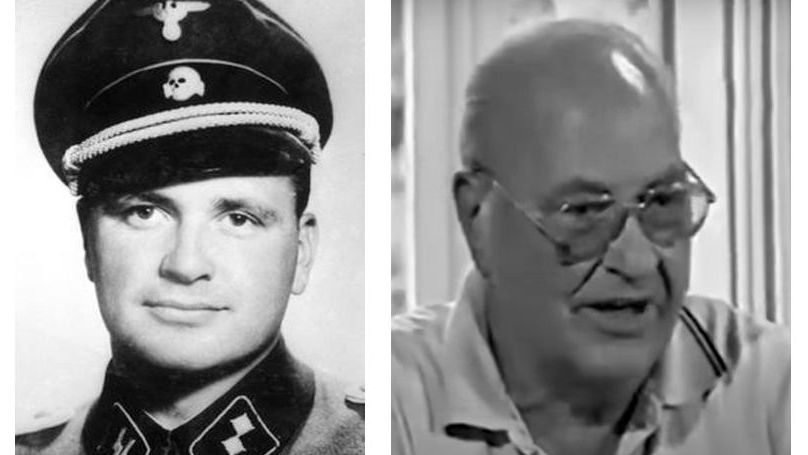
(*SS Oberscharführer Josef Oberhauser was convicted twice to short sentences and released early, lived well until 1979. Kurt Franz was arrested only in 1959; he was sentenced to life imprisonment but released in 1993 for “health reasons”. Willi Mentz was arrested only in 1965; he was sentenced to life imprisonment, but released in 1978 for “health reasons”. SS-Unterscharführer Gustav Münzberger was sentenced to 12 years imprisonment, SS-Stabsscharführer Otto Stadie – sentenced to 7 years imprisonment, SS-Unterscharführer Franz Suchomel – sentenced to 6 years imprisonment (served only 4 years), SS-Unterscharführer Erwin Lambert – sentenced to 4 years imprisonment. Most of the defendants sentenced to life imprisonment or long prison terms were released before their sentences ended. Franz was officially released in 1993 (and in fact already in the late 1970s) and died in 1998. Mentz was released in March 1978, three months before his death. Miete – released in 1985 (died in 1987), Münzberger – in 1970 (died in 1977), Suchomel – released in late 1967 (lived another 12 years).)
– A whole series of overlapping factors. Some were good at hiding. Because the focus was on punishing the more prominent criminals. Because many thought they could hide behind words that they were “just following orders”. Generally speaking, the 1950s were a time of phasing down of the denazification. There were quite a few people in Germany itself who were connected with Nazi crimes but who continued to work in various positions (above all judges with experience of Nazi justice). Naturally, it was difficult to seek sympathy and objectivity from them on the question of extermination policies. The GDR was far more consistent, but even here, things were not so simple: German guilt was shifted to the "flaws of capitalism", making public moral reflection irrelevant. We also know an example of one Treblinka guard who became a Stasi informant and was therefore sheltered from justice and the FRG requests (allegedly "not found").
Please note that in the Federal Republic of Germany since around the 1950s, the key issue for prosecutors has been the need to prove a person's voluntary complicity in a crime. And if it was alleged or indeed involuntary, this was taken into account as an acquittal, according to the theory of "subjective guilt". This is why many, for example like Suchomel, proved that they personally had not killed anyone, were personally against murders but could not oppose the criminal system. And if there was no legally acceptable evidence against them, such accomplices received minor sentences. Of course, if survivors testified en masse to the sadism and cruelty of, for example, Kurt Franz, this served as proof of voluntary complicity. Not surprisingly, he received a life sentence. If the defendant was in an administrative position, he received considerably smaller sentences and could have been acquitted. Certainly, since the Demjanjuk Trial*, West German justice has returned to the original (immediate post-war) criterion of “objective guilt”: if a person was there at the time, he is by definition guilty. For example, there is a curious story of Oskar Gröning, who was an accountant at Auschwitz and for a very long time afterwards, starting in the 1980s, when Holocaust deniers came forward, stood up and said, “No, I was there and we did kill Jews”. In 2015, he was ultimately sentenced to several years in prison, he accepted the sentence, but he never went to prison, dying of old age during the appeal. There are other cases as well. One of the Sobibor guards was acquitted because former prisoners stood up for him. History has no straightforward answers on this issue. Nevertheless, I would still follow Hannah Arendt in distinguishing between guilt and responsibility. The question of guilt is a question of the courts and the relevant legislation. The question of responsibility is a question of public opinion and moral judgement. These two logics of reasoning should not be confused.
(*John Demjanjuk, born Ivan Mykolaiovych Demjanjuk, is a former US and Soviet citizen accused of war crimes while serving as a Trawniki man and Nazi camp guard at Sobibor extermination camp, Majdanek, and Flossenbürg. At his last trial in Germany, he was convicted as an accessory to more than 28,000 murders at the Sobibor camp. In May 2011, after 18 months of trial, he was sentenced to 5 years imprisonment but the sentence did not come into force – the Appeal Court did not have time to reach a verdict before the accused died at the age of 92. This formally left Demjanjuk not convicted. In January 2020, unknown photographs from the Sobibor camp were discovered, showing the watchman Demjanjuk, known for his remarkably cruel treatment of prisoners).
From the interrogation report of Mendel Korytnicki, a former member of the Treblinka work crew, Wólka Dolna village, 23 September 1944:
“The guards severely punished the slightest attempt to communicate with anyone outside the train carriage. All night long, you could hear the guards’ shooting and the screams of the people in the wagons. For the mere request to serve water in a wagon, the guards, without saying a word, shot at the wagon. Therefore, it was no wonder that when they opened the wagons in Treblinka, half of the people were already dead. The train first stopped not at Treblinka camp itself but at Treblinka station, 2 kilometres before it reached the camp. We asked the people standing at the station where they were taking us. They all had different answers. But I do remember well what the boys told us: ‘You will pass for two kilometres and there you will have only half an hour left to live’”.
From the interrogation report of Franciszek Ząbecki, station master at the village of Treblinka, 1941-1944. Treblinka station, 24 September 1944:
“The train wagons which brought people to the extermination camp consisted, as a rule, of goods wagons. The doors of the wagons were tightly closed and the windows were covered with barbed wire. A group of up to 40 men guarded each wagon. Inside each wagon was full of people. The wagons (each) had chalk written on them indicating how many people were inside. A wagon was transporting up to 200 people, which made it terribly suffocating. People in the wagons would strip naked and ask for water through the windows. The waggon guards - Germans, Ukrainians and Latvians - took jewellery and money, promising to give them a drink, but in most cases, they took the valuables but hardly gave them any water. The Wachmänner guarding the wagons were drunk, and in response to people' cries for water, opened fire at the wagons. Very often these Wachmänner guards fired at the people in the wagons for no reason whatsoever. When a train carrying people to be exterminated in a death camp arrived at the station, there was continuous shooting. As I said before, the drunken Wachmänner shot the people in the wagons. A common occurrence was corpses of people who had died of unbearable conditions in the wagons and who were killed by the Wachmänner guards. The Germans had no regard for anything. Under such nightmarish conditions, they also transported women to the camp, who on the way gave birth to children in the wagons, dying either in the wagons or later in the death camp. I remember such a case. In August or September 1942, a trainload of people arrived at Treblinka station. It arrived in the evening, and the camp did not accept the train until the next morning. During the night, the prisoners in several wagons broke the wires that entangled the windows of the wagons and tried to escape, but the drunken Wachmänner opened fire and killed many. All of the railway’s tracks were clogged with dead bodies. The next day it took three platforms to haul away these corpses”.

An excerpt from an article by historian Aaron Schneier “The Treblinka Death Camp through the Eyes of the Trawniki-Manner”:
“Pavel Leleko, who escorted a wagon of Jews from the Warsaw Ghetto to Treblinka in August 1942, and was left at the camp along with 30 other wagon-guards, interrogated on 20 February 1945 in the 4th Department of the SMERSH of the 2nd Belorussian Front, testified:
‘When the wagon was full, the German in charge of loading entered it and began whipping faces and bodies with a rubber whip fitted with a metal tip... The crowd in the wagon began to shout, crowded to the sides, and more people were forced into the empty space in the wagon. The wagon door was then slammed shut. The loading continued for another two hours. The guards shot those attempting to escape or who resisted. The screaming and moaning continued throughout the loading process. After about half an hour, the train, which numbered up to 60 wagons, headed east. At about five stops along the way, we cordoned off the train to prevent any escapes and prevented the Polish population from getting near the wagons in order to sell or give prisoners water or food. People in the wagons were suffocating from the heat and thirst, cries for “water”, “thirst”, moans, shouts, howls of people going mad, cries of the fatally wounded ceaselessly bubbled from the wagons. Desperate people, in full view of the police, tried to climb out of the windows and flee but were shot and killed.
(...) At one of the stops, a young woman with her child struggled to get out of the window of a wagon and, holding the child in front of her, began to cry loudly for a drink of water for the child. One of the Germans shot at her; the woman was killed, unclasped her arms, and fell into the wagon. The child crashed from the height of the wagon onto the rail sleepers. The German, who had shot the woman, went over to the child, who was bleeding, and grabbed the dress and tried to throw the child into the wagon through the window vent, but he missed. The child hit the wagon wall and fell back onto the sleepers. The German then took a long stick, wrapped the child's clothes around it and pushed him into the wagon through the window opening. The Germans and police officers present at this scene laughed merrily. The shooting at the wagons was relentless. People were sticking their hands through the cracks with large sums of money, begging for even a sip of water. The Germans and police officers took the money but did not even think of bringing water. One German took his sabre out of its sheath. He approached the wagon, quietly, from which a woman's arm was sticking out with a bundle of money in her fist, and with a full swing slung the sabre down on the arm. The chopped-off hand, almost up to the elbow, flew aside, splattering the German's suit with blood. Ignoring this, he walked over to the severed hand, unclenched its fingers and, having taken the money, slipped it into his pocket. Then took out a banknote, and wiped the sabre. I took a thousand zlotys from one prisoner but did not bring him any water. Local people tried to give the prisoners water but we chased them away, took the water from them, and poured it on the ground”.
From a discussion on Konstantin Pakhalyuk's Facebook page:
Konstantin Pakhalyuk: About fifty Germans served in Treblinka, and in other death camps, too. Not so many Germans were in Babi Yar or Khatyn. Or in the Einsatzgruppen. Their harsh punishment would not have killed the nation, and others, seeing that - maybe! - would not call for large-scale revenge. I would not generalise or overshadow the main point: the excessive "leniency" of justice against those who are definitely guilty. This is what creates that wave of backpressure, the righteous anger.
Sergey Romanov: There was no need to shoot everyone, only murderers and the like. Most German men were not subject to any reasonable “capital punishment” law. The logic in West Germany (where the death penalty was abolished in 1949) was then simple – judgement according to our criminal code, in the Criminal Code Section 211 the murder is non-trivial, “niedrige Beweggründe” is required, that is the murder had to be committed out of base motives (sexual gratification, enrichment etc.). A superior order was therefore not a total indulgence but reclassified “Mord” to “Beihilfe zum Mord”, that is being an accomplice, punishable by fairly modest sentences. Decent sentences were handed down for those defendants for whom it was possible to prove crimes that had been committed outside the official orders, in addition to them. That being said, the core of the present-day Section 211 with its legal quibbling, formulated in 1941 under [Roland] Freisler, certainly makes this whole situation special.
Read more here. (Link to “The Hell of Treblinka. Part Two”)
Link to “Not Even Satan Could Have Thought Up More Wretched Torture”
